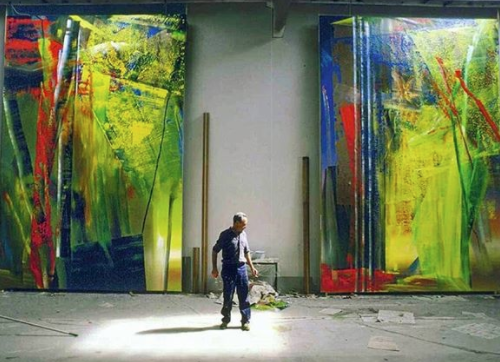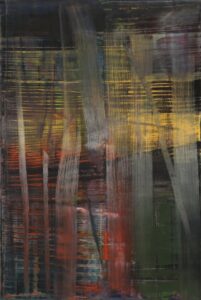Abstract representation

Gerhard Richter with his work
The shot of these two huge abstracts, with Gerhard Richter dwarfed by his work while posing in the shaft of light, appeared on Instagram at abstrac.ted. I can’t find anything quite like them in the compendium of Richter’s work over the decades at Gerhard Richter. I’m wondering if this means he has recently completed these, and if so, it’s an interesting shift in his work. With the exception of a series he did in 2005, all entitled Forest, these two paintings distinguish themselves from almost all of his earlier, extremely flat

Forest
abstracts, obedient to Clement Greenberg’s advocacy of flatness as painting’s most essential, defining characteristic–what, in retrospect, seems like either the silliest or the most obvious proposition about art ever to be embraced in such a hugely influential way. In the bulk of his abstract paintings, Richter experiments with the effects he can get by using large amounts of multiple colors, smearing, masking, scraping, scumbling (on a large scale) one color into another in various ways. In the earlier work, he achieves suggestive effects of luminosity and hints of depth—so that some areas of paint seem to recede to an area just behind the surface. In the Forest series, this is more pronounced: you can discern what might be tree trunks in a foreground, or an underwater scene with tiers of aquatic plant life, against an indeterminate soup behind them, in a way that feels slightly Klee-like. Landscapes blur into twilight. But in this pair of huge canvases, the sense of space is vast, giving a sense of receding vistas. Light seems to shoot down through layers of foliage or enormous skylights, and the vertical shafts to the left in each canvas suggest buildings, or maybe the geometric angles of Richter’s studio itself. In the painting on the left, down in the lower right corner, the rectangular area of softened light seems like a window that offers a glow reaching the viewer from miles away. More than most of his abstraction in the past, this work from Richter, if it’s recent, gives reason to hope he’s trying to find a closer, expressionist truce between abstraction and his celebrated genius as a realist.
Comments are currently closed.